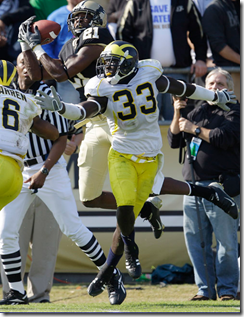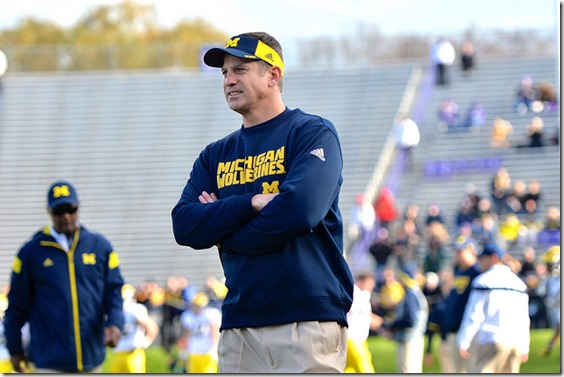Nuss went from sense-bringing savior to Brandon crony really in one trip to South Bend. And he didn’t even make our list.
The Question:
The assistant you changed your opinion on the fastest, negative or positive? Note: this was inspired by a conversation about Durkin, whom nobody took. In fact we probably left a lot of answers on the table in trying to avoid the obvious.
-------------------------------------
The Responses:
Adam: I was on the fence when Jedd Fisch was hired; he hadn't spent more than two seasons anywhere since his time as an assistant QB/WR coach with the Ravens from 2004-2007, and his stints as an offensive coordinator in college and the NFL yielded uninspiring results. One need only look as far as his Hello post to see that advanced stats weren't kind to his tenure as a college or pro OC outside of one shiny FEI number in 2011.
You shouldn't judge based on a limited data set, and Fisch's work is a reminder why. Jake Rudock, already a pretty good quarterback when he got to Ann Arbor, saw his completion percentage rise 2.1% and his yards per attempt rise 0.7 yards to 7.8 from 2014 to 2015. The Harbaugh caveat applies, but the receivers also made big year-to-year improvements.
[After the jump: another thinks—we had them coming]

Amara Darboh's catch rate rose 6.7% and his yards per target increased by 0.5 from 2014 to 2015 to a total of 7.6 YPT. Jehu Chesson's catch rate didn't rise as much as Darboh's (up 4.2% to 62.5% in 2015), but his yards per target jumped a massive 3.2 to 9.6 YPT in 2015. RYPR, a Bill Connelly measure that looks at a receivers production, how important they are to their team, how good the team's passing game is, and how often the team passes, was not kind to Darboh (201st overall) and Chesson (665th) in 2014. By 2015, both players were basically in the top 50, with Darboh 53rd overall and Chesson jumping up 620 spots to 45th.
From Fisch admonishing Harbaugh to run a play that wasn't on the call sheet that ended up winning the game against in Indiana in double OT to the "good shit, Jedd" gif to the efficacious screen game for which Harbaugh heaped praise on Fisch, the year ended with his one-year contract as cause for concern, not celebration.
All of the advanced stats provide strong supporting evidence but don't consider the most important number: two, the number of years Fisch's contract was extended a few months ago. Using the Indiana game as the point where my opinion had completely flipped, it took only 11 months to go from thinking his title was a fancy way of saying he's a WR coach to viewing him as either the de facto offensive coordinator or co-OC and as responsible as anyone for the offense's growth.
-------------------------------------
David: Lavall Jordan was hired by John Beilein after the disastrous 09-10 season. That season went down in flames and in order to save his job, Beilein completely remade his staff. He poached Jordan from rival Iowa, who also had a mediocre season.
Though not highly-touted, Lavall came to be known as a "guard developer." He started off very quickly turning Darius Morris into one of the best guards in the B10. His PPG went from 4 to 15, APG from 2.4 to 6.7, and his 3FG% from a paltry .179 to an increased .250, including All-B10 honors. It might have worked too well and Morris left after his sophomore year to go to the NBA.
Guys that followed include: Trey Burke, Nik Stauskas, Caris LeVert. Burke went from a PSU-bound 3* to POY and a Top 10 NBA draft pick. Stauskas was a lot higher rated, but after blowing up in his sophomore year, he followed the 2 years and out trend and also became a Top 10 pick in the draft. LeVert was a little different. He wasn't as coveted as the previous few guys, but still has a lot of potential for a post-March class-filler. LeVert returned for both his junior and senior seasons, but neither worked out for him health-wise. It remains to be seen where he'll get drafted, but after his junior season he was talked about as a borderline lottery pick.
Over the last couple seasons, you could see the development in guys like Rahk and Irvin. Rahk came in as a super raw athlete and has turned into...maybe Michigan's most well-rounded player? Irvin also has grown his game from Just A Shooter to a bit of a drive-and-kick player. Jordan won't be around for the end of either of those careers, but their progression has been easily noticeable.
Lavall Jordan was considered for the Butler head coaching job a few seasons ago. He was ultimately passed over, but UW-Milwaukee finally came calling in early April. He has done a lot for Beilein and Michigan in his six seasons and certainly deserves and opportunity to see if he can run his own ship. It also works well for Michigan because when Beilein retires in the not-too-distant future, Michigan should have some indication of what Jordan looks like making all of the decisions.
-------------------------------------
Seth: I may be betraying my own folly here but, well, West Virginia's pass defense was ranked 2nd in S&P+ in 2007, and Tony Gibson had turned Ryan Mundy into an NFL prospect in a year after three of that guy wandering lost in Michigan's defensive backfield. It was 2008, and we were young and in love with Rich Rod's modernization mandate, Barwis's wolves, and advanced maths, and I clung to that ranking which probably had a lot to do with Jeff Casteel's diabolical blitzes.
 |
| Before “Never Forget” starting taking its toll we got a preview of 3-3-5 hell on the day RR put Gibson in charge. [via DetNews] |
Through much of 2008 the only major hit to my inflated rating of Gibson's stock was when Juice Williams turned Michigan's entire defense into a twitching pile of goo. By Penn State Donovan Warren had perceptively checked out, and they were doing panicky things like inserting Cissoko.
Then came Purdue, when the defense suddenly switched to a 3-3-5 stack that didn't cover out routes. Since Shafer was a 4-3 guy his whole life, and Gibson was the chief representative of the West Virginia Party, it didn't take long to deduce there'd been some sort of coup, and who was in charge. In the UFR Brian openly asked...
>"Is Gibson completely inept or something? He was one of the two guys who made an appearance with Rodriguez at his first Michigan press conference (Magee was the other) and therefore is subject to accusations of Debordian cronyism from the skeptical; he and Rodriguez have been joined at the hip for a long time. West Virginia fans were mostly glad to be rid of him."
I made my name with a series documenting the personnel problems underlying the "Never Forget" era of Michigan's secondary, and Lloyd's players and staff can shoulder as much of the blame for rejecting the transplant as Rodriguez's staff. There's also recruiting Denard to Michigan, and Gibson has done very well as WVU's defensive coordinator (with an underrated assist from now-UCLA DC and onetime Paterno heir apparent Tom Bradley). But if we're talking about dramatic changes in perception, nobody can match the drop from unreasonable high to unfair low that Gibson undertook in November 2008.
-------------------------------------
Ace I was a freshman in 2006, the year defensive backs coach Ron English took over as defensive coordinator from Jim Hermann. This was before I followed position coaches much at all, so for me, English entered with a clean slate.
 |
| Back when Ron English ended a dominant season with a total misfire at Ohio State it didn’t earn you the Maryland job. [via MGoBlue] |
For the first nine games, the defense absolutely kicked ass. The run defense was impenetrable, the pass rush was fearsome, and Leon Hall was a great number one corner. I watched with glee from the student section as David Harris patrolled sideline-to-sideline, Shawn Crable mad storked his way around blockers, and LaMarr Woodley killed people. While Michigan’s offense wasn’t bad themselves, I couldn’t wait to see English’s vicious cohort of demons get back on the field.
In an oddly timed non-conference game, a 3-6 Ball State squad came to Michigan Stadium for what would be undefeated Michigan’s final tune-up before The Game. While the defense didn’t exactly falter, they allowed BSU to hang around; at the time, most figured the too-close-for-comfort 34-26 win was simply a product of the team looking ahead to Football Armageddon.
Instead, it was a harbinger of doom. Instead of a heated defensive battle, The Game quickly turned into a shootout, and it revealed just how little Michigan was prepared for the new era of spread offenses. All year, the defense had crushed a series of pro-style plodders, but English had no idea how to counter OSU’s three- and four-wide sets with Troy Smith taking snaps.
In the waning moments of the first half, the Buckeyes—already up a touchdown—drove deep into Michigan territory. OSU emptied the backfield, sticking future first-rounder Anthony Gonzalez in the slot. English decided the best way to defend this was to put Chris Graham, a 230-pound inside linebacker, in man coverage on a NFL-level slot receiver. You’ll never guess what happened next.
Ohio State shredded Michigan to the tune of 7.2 yards per play. In the Rose Bowl, USC ripped apart the secondary in the second half to cruise to a win. The next season, Michigan played their first two games against modern spread offenses.
I’ll spare you the details. Needless to say, I was no longer a fervent Ron English supporter.


















